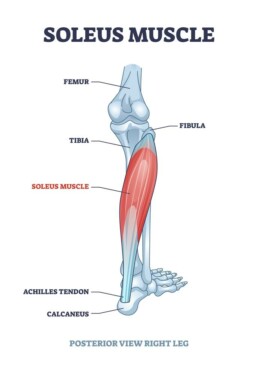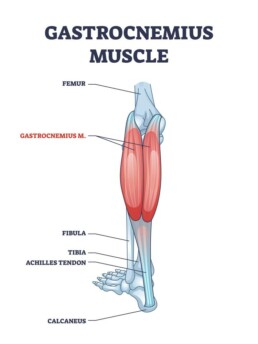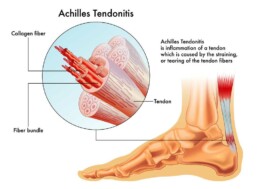Understanding the Achilles Tendon
Tendons are the tissue fibres that connect the ends of our muscles to our bones. The Achilles tendon connects the major calf muscles – the gastrocnemius and the soleus – to the back of the heel. It helps us lift our heels off the floor and to push off when we run or jump. The tendon is named for Achilles, the man of ancient Greek legend whose mother held him by the heel to dip him into the River Styx to give him invulnerability – everywhere but the heel, which became his downfall in battle.


What is Achilles Tendonitis?
Achilles Tendonitis occurs when the tendon becomes swollen and painful and is caused by repetitive or intense strain. It is considered an overuse injury. Runners suddenly increase their workloads are subject to it, as are people who participate in sports only on weekends. Runners may also experience Achilles Tendonitis when they run too fast; tackle too many hills or those that are too steep; pronate as their feet strike the ground; or don’t take appropriate breaks between runs.

Different Types of Tendonitis
There are two types of Achilles Tendonitis: reactive and degenerative. Reactive Achilles Tendonitis is usually a response to a sudden increase in training load. A sufferer usually feels pain when beginning a run, but it will ease off as the run progresses, only to reappear afterward. On a scale of intensity, with 10 the worst pain, pain from this type of Achilles Tendonitis is usually a 3/10.
Degenerative Achilles Tendonitis or late disrepair is usually the result of ongoing overtraining and is generally seen in older runners. It results in changes to the tendon’s tissue – you may notice it thickening — and its ability to tolerate load. Without treatment, the tendon may be subject to rupture.
Be aware that the reactive type of Achilles Tendonitis may progress over time to degenerative tendonitis.
Is It OK To Run With Achilles Tendonitis?
As long as your Achilles Tendonitis remains in the reactive stage with pain that is a manageable 3 out of 10 and the symptoms subside a day after running, it is okay to continue your training, adapting based on the pain. However, if the pain becomes more severe and takes longer to subside, heed these warning signs. They are signals that your Achilles Tendonitis is moving from reactive to degenerative. Take a two week break from running and consult a licensed physiotherapist. It is probably time to focus on rehabilitation of your tendon, rather than on accumulating miles.
Once your physiotherapist tells you that you are ready to return to running, you’ll need to do so gradually. Overloading your tendon is what landed you in this situation in the first place, so increase your workload bit by bit.
If you do have reactive Achilles Tendonitis, you can generally keep running by adjusting your training plan. Rather than running daily or five times a week, alternate your running days with low-impact cross training – exercises such as cycling, swimming or rowing. These exercises will keep you fit without putting pressure on your tendon.
How Do I Stop My Achilles Tendon From Hurting When I Run?
When running with Achilles Tendonitis, be sure to start your workout sessions with at least 10 minutes of dynamic stretching to prepare warm up your tendon. Start by walking slowly and progressively increase the pace. You’ll help prevent pain once you begin to run.
As you plan your workouts, be conscious of the load your tendon is bearing and add to it gradually. Hill workouts and speed sessions may be detrimental if you aren’t careful, so reduce them or consider eliminating them until you heal.
As mentioned earlier, cross training is an ideal way to keep in shape and prepare your body for running. In addition to cycling, swimming or rowing, there are options such as Aquafit and exercises that strengthen your tendons, such as heel raises and plyometrics. Exercises for your hip muscles are also beneficial.
Finally, consider switching shoes. If your shoes have a heel stack of less than 10 millimetres, get a new pair (see below). If a new pair isn’t affordable, consider heel lifts to remove some of the pressure on your tendon.
Do Running Shoes Help With Achilles Tendonitis?
If you are suffering from Achilles Tendonitis, wearing the correct running shoe can help you manage it by reducing pain, increasing your capacity for running and assisting in overall rehabilitation. When shopping for shoes, select one with a deep heel cup, a rigid midsole and a stack drop of 10 millimetres (mm) or more. The deep heel cup helps to control your subtalar joint; when combined with a rigid midsole, it helps control pronation and relieve your tendon pain.
The heel stack refers to the running shoe’s difference in height between the back and front of the shoe. Research indicates that a raised heel helps relieve Achilles Tendonitis pain.
Shoe Fitting Guide for Different Foot Types
Consider these three shoes when you suffer from Achilles Tendonitis:
- Brooks Adrenaline. This running shoe offers stability. It has a 12 mm stack drop to help control Achilles pain and offers a moderate level of cushioning. Choose this model if you have mild Achilles Tendonitis symptoms and require moderate stability.
- Brooks Ghost 14. This shoe works for both running and the gym. The 12 mm stack drop shortens the Achilles and alleviates pain. It is useful for long distance runners experiencing mild to moderate Achilles pain.
- Asics Gel Kayano. This is a maximum stability shoe for road running. The deep heel cup and rigid midsole help control pronation, while the 13 mm stack drop relieves tension on the Achilles tendon. It is helpful for those with moderate to severe Achilles Tendonitis.
If you have any concerns or are seeking a more individualized workout plan, don’t hesitate to turn to your physiotherapist for guidance. It’s their job to help keep you moving – safely!
